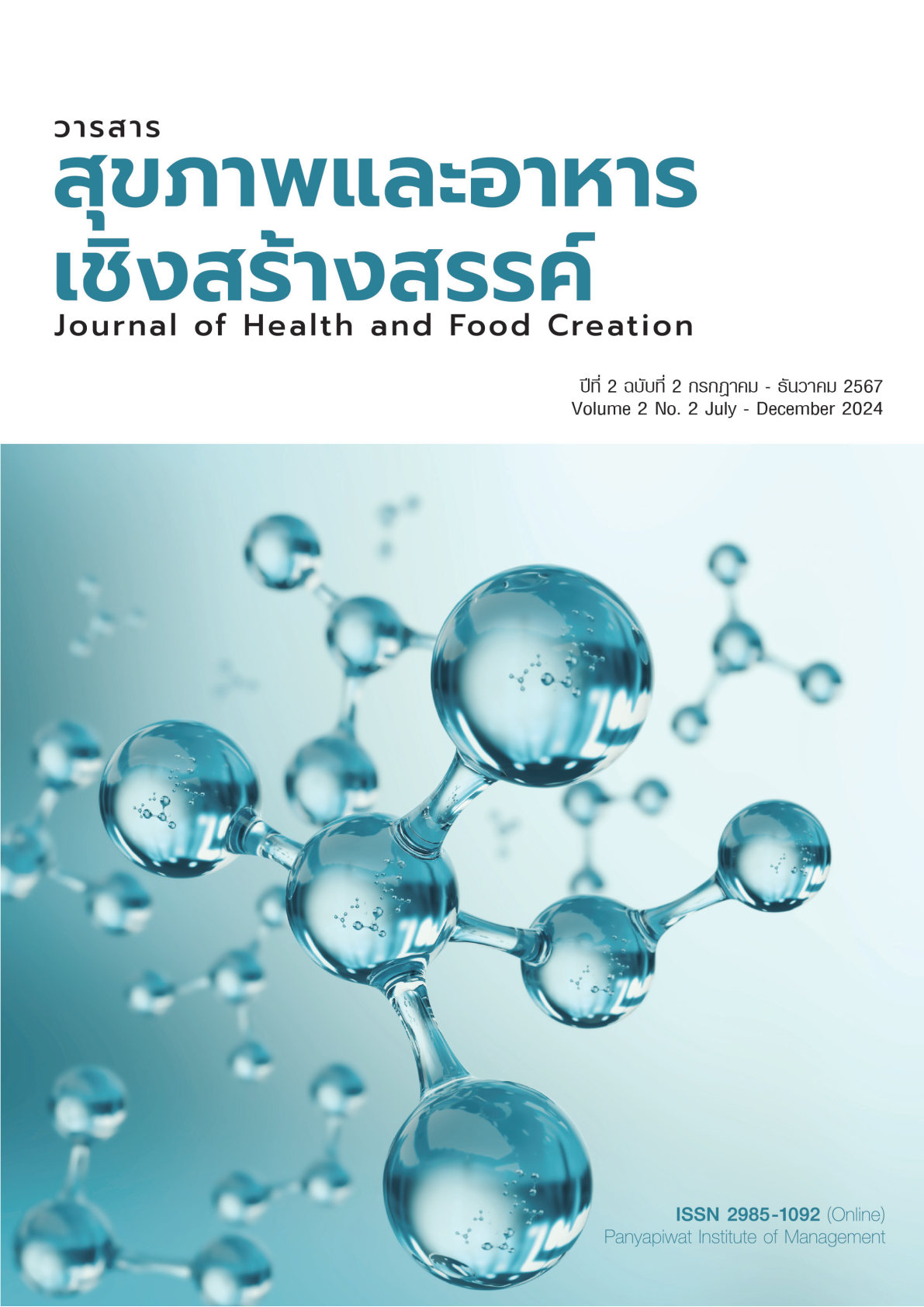DEMAND FOR AN INTERNET OF THINGS-BASED HEALTH MONITORING PATTERN TO PREVENT FALLS IN THE ELDERLY
Keywords:
Needs Assessment, Fall Monitoring, Elderly, Wearable Device, Internet of ThingsAbstract
This research aimed to investigate the requirements for health monitoring pattern to prevent falls in the elderly within the Internet of Things (IoT) context. The further outcome is in order to develop an information technology model that leverages IoT technology to monitor health conditions, mainly focusing on fall detection. The IoT is the network of physical objects “things” that are embedded with sensors, software, and smart wearable for the purpose of connecting and exchanging data with other devices over the internet. Data was collected from 100 elderly individuals who received healthcare services at Somdej Phra Sangkharat Yanasangwon Geriatric Hospital. A questionnaire with CVI 0.9 was used to collect data. The general data and the data of requirements for health monitoring pattern to prevent falls in the elderly within the Internet of Things (IoT) context were analyzed by descriptive statistic.
The results showed that 79% of the samples preferred wrist-worn wearable devices for biometrics monitoring. Additionally, 100% of the samples expressed a need for devices and applications capable of detecting falls and automatically notifying caregivers or relatives via a mobile application. Furthermore, there was a demand for a service that provides information on nearby emergency services in case of an incident.
References
Barajas-Nava, L. A., Garduno-Espinosa, J., Mireles Dorantes, J. M., Medina-Campos, R., & Garcia-Pena, M. C. (2022). Models of comprehensive care for older persons with chronic diseases: A systematic review with a focus on effectiveness. The British Medical Journal, 12(8), e059606. https://doi.org/10.1136/bmjopen-2021-059606
Cardoso da Silva, A., Cordeiro de Oliveira, L., Martins Dos Santos, H., Caldeira Monteiro, B., Santos Pereira, G., Sulyvan de Castro, S., & Silva, S. M. (2024). Validation of tele-assessment of disability and health after stroke using WHODAS 2.0 through video call in a middle-income country. Topics in Stroke Rehabilitation, 2024, 1-10. https://doi.org/10.1080/10749357.2024.2403811
Chung, J., Brakey, H. R., Reeder, B., Myers, O., & Demiris, G. (2023). Community-dwelling older adults’ acceptance of smartwatches for health and location tracking. The International Journal of Older People Nursing, 18(1), e12490. https://doi.org/10.1111/opn.12490
Department of Disease Control. (2023). Falls data in elderly people aged 60 years and over. Ministry of Public Health. https://ddc.moph.go.th/dip/news.php?news=23567&deptcode= [in Thai]
Department of Older Persons. (2024). Elderly statistics. https://www.dop.go.th/th/know/1 [in Thai]
Dorri, S., Zabolinezhad, H., & Sattari, M. (2023). The application of internet of things for the elderly health safety: A systematic review. Advanced Biomedical Research, 12(1), 109. https://doi.org/10.4103/abr.abr_197_22
Foundation of Thai Gerontology Research and Development Institute. (2015). A guide to preventing falls in the elderly. http://agingthai.dms.go.th/agingthai/wp-content/uploads/2020/10/edit-03122020-17.pdf [in Thai]
Friedrich, B., Elgert, L., Eckhoff, D., Bauer, J. M., & Hein, A. (2023). A system for monitoring the functional status of older adults in daily life. Scientific Reports, 13(1), 12396. https://doi.org/10.1038/s41598-023-39483-x
Hong, C., Sun, L., Liu, G., Guan, B., Li, C., & Luo, Y. (2023). Response of global health towards the challenges presented by population aging. China CDC Weekly, 5(39), 884-887. https://pmc.ncbi.nlm.nih.gov/articles/PMC10560387/
Institute of Geriatric Medicine. (2021). Falls in Thai elderly. Department of Medical Services. http://agingthai.dms.go.th/agingthai/wp-content/uploads/2021/01/book_3.pdf
Kumar, S., Tiwari, P., & Zymbler, M. (2019). Internet of things is a revolutionary approach for future technology enhancement: A review. Journal of Big Data, 6, 111. https://doi.org/10.1186/s40537-019-0268-2
Lerspalungsanti, S. (2024). Gunther bath: Ambient fall detector. National Science and Technology Development Agency. https://www.nstda.or.th/nac/2023/exhibitions/ex42/ [in Thai]
Mattison, G., Canfell, O., Forrester, D., Dobbins, C., Smith, D., Toyras, J., & Sullivan, C. (2022). The influence of wearables on health care outcomes in chronic disease: Systematic review. Journal of Medical Internet Research, 24(7), e36690. https://doi.org/10.2196/36690
Moathong, P., ThongKhotr, W., & Ungpansattawong, S. (2017). Determining the sample size by the Yamane’s formula. https://sc2.kku.ac.th/stat/statweb/images/Eventpic/60/Seminar/01_9_Yamane.pdf [in Thai]
National Innovation Agency. (2018). “Dinsow Mini” elderly care service robot. https://www.nia.or.th/หุ่นยนต์บริการดูแลผู้สูงวัย.html [in Thai]
Naumova, E. N. (2024). Artificial intelligence and data analytics competencies for public health professionals. Journal of Public Health Policy, 45(3), 407-412. https://doi.org/10.1057/s41271-024-00499-w
Panyakong, S., Jantanil, S., Jairakdee, K., Kambunlua, O., & Prarom, S. (2022). The warning shoes innovation to prevent falling. In Proceedings of the 2nd Kamphaeng Phet Rajabhat University Student National Conference (pp. 635-642). Kamphaeng Phet Rajabhat University. https://research.kpru.ac.th/research2/pages/flere/1650169277.pdf [in Thai]
Peng, Y., Wang, H., Fang, Q., Xie, L., Shu, L., Sun, W., & Liu, Q. (2020). Effectiveness of mobile applications on medication adherence in adults with chronic diseases: A systematic review and meta-analysis. Journal of Managed Care and Specialty Pharmacy, 26(4), 550-561. https://doi.org/10.18553/jmcp.2020.26.4.550
Quintana, Y. L., & Cruz, L. M. (2022). Review of management models for needs assessment to acquire biomedical equipment. Health and Technology, 12, 1-8. https://doi.org/10.1007/s12553-021-00625-8
Sajjarak, K., & Chujai Mechel, P. (2023). Fall detection and notification system for the elderly using a portable embedded IoT system. King Mongkut’s University of Technology Thonburi (KMUTT). https://kirim.kmutt.ac.th/converis/portal/detail/Publication/1450153128?lang=de_DE [in Thai]
Silawan, T., Powwattana, A., Ponsen, P., & Ninkarnjanakun, N. (2024). Promoting the wellness of older adults through integrated health-promoting programs and supportive peers: A quasi-experimental study in semi-urban communities of northeastern Thailand. Journal of Primary Care and Community Health, 15, 21501319241241456. https://doi.org/10.1177/21501319241241456
Whanngern, A. (2014). Development of a prototype system to prevent patient’s fall from bed using gesture recognition technique [Master’s thesis]. Chulalongkorn University. [in Thai]
Wimolphan, P., & Pitchalard, K. (2014). Effect of a fall prevention program on falls among elderly people. Nursing Journal of the Ministry of Public Health, 23(3), 98-109. https://he02.tci-thaijo.org/index.php/tnaph/article/view/16632 [in Thai]
Wongyai, C., Puckdeevongs, A., & Buayamsang, S. (2020). A development of fall detection systems using wristband. In Proceedings of the 5th National and International Conference (pp. 249-257). Rangsit University. https://rsucon.rsu.ac.th/fles/proceedings/nation2020/NA20-083.pdf [in Thai]
Yongkong, P., Pingmuang, W., & Sri-ngernyuang, C. (2018). Bed movement monitoring and notification system. Institute of Field Robotics (FIBO), King Mongkut’s University of Technology Thonburi. https://www.thailandtechshow.com/view_techno.php?id=778 [in Thai]
Downloads
Published
Issue
Section
License
Copyright (c) 2024 Journal of Health and Food Creation

This work is licensed under a Creative Commons Attribution-NonCommercial-NoDerivatives 4.0 International License.
“ข้าพเจ้าและผู้เขียนร่วม (ถ้ามี) ขอรับรองว่า บทความที่เสนอมานี้ยังไม่เคยได้รับการตีพิมพ์และไม่ได้อยู่ระหว่างกระบวนการพิจารณาลงตีพิมพ์ในวารสารหรือแหล่งเผยแพร่อื่นใด ข้าพเจ้าและผู้เขียนร่วมยอมรับหลักเกณฑ์การพิจารณาต้นฉบับ ทั้งยินยอมให้กองบรรณาธิการมีสิทธิ์พิจารณาและตรวจแก้ต้นฉบับได้ตามที่เห็นสมควร พร้อมนี้ขอมอบลิขสิทธิ์บทความที่ได้รับการตีพิมพ์ให้แก่สถาบันการจัดการปัญญาภิวัฒน์หากมีการฟ้องร้องเรื่องการละเมิดลิขสิทธิ์เกี่ยวกับภาพ กราฟ ข้อความส่วนใดส่วนหนึ่งและ/หรือข้อคิดเห็นที่ปรากฏในบทความข้าพเจ้าและผู้เขียนร่วมยินยอมรับผิดชอบแต่เพียงฝ่ายเดียว”





